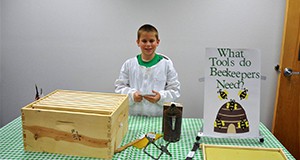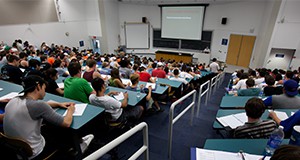Regardless of workspace or class setting, group work has gotten a reputation for being less than pleasant. However, when individuals have the opportunity to prepare for group work via understanding their personal strengths, expectations, and perspectives, the not-so-popular group work can often turn into pleasant, productive, and collaborative engagement. Because group dynamics shift and vary from group to group, there is a constant learning opportunity to understand how to work in groups successfully. This new 2-page publication of the UF/IFAS Department of Agricultural Education and Communication will identify simple yet effective strategies that can serve as foundational building blocks whenever preparing oneself or others for group work. Written by Cecilia E. Suarez and Jarred A. Shellhouse.
https://edis.ifas.ufl.edu/wc389
Tag: Teaching Methods
Foundations of Effective Classroom Management
Classroom management can be challenging for teachers. While managing a classroom requires flexible approach, there are some basic strategies than can be used to make the classroom safe and engaging. This new 3-page article provides recommendations to teachers to manage student behavior in the agriculture classroom. Written by Kelsey M. Thornton, R. G. (Tre) Easterly III, and Ed Osborne, and published by the UF/IFAS Department of Agricultural Education and Communication.
https://edis.ifas.ufl.edu/wc381
Teaching for Extrinsic Motivation

Motivation is the idea of being moved to do something, and levels of motivation vary among every individual. Extrinsic motivation is a specific type of motivation that is fueled by external rewards or an expected outcome. This 2-page document, written by Isabella Damiani, Andrew Thoron, and J. C. Bunch and published by the UF/IFAS Department of Agricultural Education and Communication, discusses how educators can foster extrinsic motivation among their students.
http://edis.ifas.ufl.edu/wc307
Teaching and Learning: Motivating Learners
Motivation is a process that drives individuals forward. Educators must be aware of the continuum of motivation and appropriately provide opportunities for student engagement, learning, and growth. This 2-page document discusses how to motivate learners. Written by Isabella Damiani, Andrew Thoron, and J. C. Bunch and published by the UF/IFAS Department of Agricultural Education and Communication, May 2018.
http://edis.ifas.ufl.edu/wc305
Utilizing Demonstrations in Teaching, with An Example Demonstration of Plant Propagation via Cuttings
In a learning environment, it is important to provide instruction to each type of learner. This 4-page document discusses utilizing demonstrations for different types of learners and includes a sample demonstration of plant propagation. Written by Isabella Damiani, Andrew Thoron, and J. C. Bunch and published by the UF/IFAS Department of Agricultural Education and Communication, May 2018.
http://edis.ifas.ufl.edu/wc306
Instructional Design Using the Dick and Carey Systems Approach
Instructional design is a system of procedures used for developing instruction and training curricula in a consistent and reliable method. This 5-page publication applies the best practices of instructional design using the Dick and Carey systems approach. Written by Tyler D’Angelo, J. C. Bunch, and Andrew Thoron and published by the UF/IFAS Department of Agricultural Education and Communication, March 2018.
http://edis.ifas.ufl.edu/wc294
Principles and Practices to Secure and Hold Interest

Securing and holding student interest is a major challenge for teachers. Once the curriculum is set, then teachers must decide how to teach the content, particularly how to build lasting interest in the content being taught. Students learn more and retain what they have learned longer when they are interested in the content, see its usefulness, and are motivated to learn and apply what they have learned. This three-page fact sheet discusses what makes a topic or lecture interesting for students and ways to improve teaching methods to keep students engaged and interested in the subject matter. Written by R. Kirby Barrick and Andrew C. Thoron, and published by the Agricultural Education and Communication Department.
http://edis.ifas.ufl.edu/wc242
Writing Instructional Objectives

Good teaching begins with well-written instructional objectives. Instructional objectives identify the knowledge, skills, and abilities that students will possess upon successfully learning the material. This four-page fact sheet outlines the three types of objectives (cognitive, psychomotor, and affective) as well as the different components of objectives (condition, performance, criterion). A well-written instructional objective will lead to clear teaching and ultimately, student success. Written by R. Kirby Barrick and Andrew C. Thoron, and published by the Agricultural Education and Communication Department.
http://edis.ifas.ufl.edu/wc245
Teaching Behavior and Student Achievement

Student achievement can clearly be enhanced through effective teaching behaviors, but what kinds of teacher behaviors lead to higher achievement among learners? This six-page fact sheet describes five different teacher behaviors that can lead to higher student achievement. These behaviors are clarity, variability, Enthusiasm, task oriented and/or businesslike behavior, and student opportunity to learn criterion material. Written by R. Kirby Barrick and Andrew C. Thoron, and published by the Agricultural Education and Communication Department.
http://edis.ifas.ufl.edu/wc244
Principles of Teaching and Learning

Effective teaching involves careful consideration and planning. There are several different principles that can be used to guide teachers in planning their lessons. This two-page fact sheet provides information on how to organize and structure subject matter, motivate students, effectively use reward and reinforcement, and other techniques for instruction. Written by R. Kirby Barrick and Andrew C. Thoron, and published by the Agricultural Education and Communication Department.
http://edis.ifas.ufl.edu/wc243
Teaching to Personality Types series

A person’s personality affects the way he or she learns best. Extension programs can use an understanding of different learning styles and preferences to reach the greatest number of people. This 4-part series covers the various personality types and explains how Extension can teach to these types. Written by Alexa J. Lamm and Ricky W. Telg, and published by the UF Department of Agricultural Education and Communication, September 2015. (Photo credit: Rawpixel Ltd/iStock/Thinkstock.com)
http://edis.ifas.ufl.edu/topic_series_teaching_to_personality_types
Do a Visual Presentation
 A visual presentation, either a demonstration or an illustrated talk, is a teaching method in which the presenter shares information with an audience with the assistance of visual aids such as posters, models, and computer presentation software. This 4-page fact sheet covers the method of delivery, the plan, the visuals, how to look sharp and to have a sharp presentation. Written by Stacey Ellison, and published by the UF Department of 4-H Youth Development, June 2015.
A visual presentation, either a demonstration or an illustrated talk, is a teaching method in which the presenter shares information with an audience with the assistance of visual aids such as posters, models, and computer presentation software. This 4-page fact sheet covers the method of delivery, the plan, the visuals, how to look sharp and to have a sharp presentation. Written by Stacey Ellison, and published by the UF Department of 4-H Youth Development, June 2015.
http://edis.ifas.ufl.edu/4h163
Cooperative Learning for 4-H
 A simple way to facilitate discovery through cooperative learning, in which learners work together to meet a shared goal with a leader guiding them to encourage group interactions. This 5-page fact sheet provides teaching techniques and applies cooperative learning to natural resources and environmental literacy in the context of 4-H. Written by Jessica McIntosh and Martha Monroe, and published by the UF Department of School of Forest Resources and Conservation, September 2014.
A simple way to facilitate discovery through cooperative learning, in which learners work together to meet a shared goal with a leader guiding them to encourage group interactions. This 5-page fact sheet provides teaching techniques and applies cooperative learning to natural resources and environmental literacy in the context of 4-H. Written by Jessica McIntosh and Martha Monroe, and published by the UF Department of School of Forest Resources and Conservation, September 2014.
http://edis.ifas.ufl.edu/fr390
Attribution Theory: How is it Used?
 Attribution theory is defined as the way that individuals envision the success or failure of their own behavior or the behavior of others. This 4-page fact sheet explains how instructors, whether formal or informal, can use this theory in their learning environment to enhance their learners’ knowledge and comprehension. Written by Eric D. Rubenstein and Andrew C. Thoron, and published by the UF Department of Agricultural Education and Communication, September 2014.
Attribution theory is defined as the way that individuals envision the success or failure of their own behavior or the behavior of others. This 4-page fact sheet explains how instructors, whether formal or informal, can use this theory in their learning environment to enhance their learners’ knowledge and comprehension. Written by Eric D. Rubenstein and Andrew C. Thoron, and published by the UF Department of Agricultural Education and Communication, September 2014.
http://edis.ifas.ufl.edu/wc162
Making Learning Fun
 As a 4-H volunteer, one of your most important roles is helping youth learn. Especially because membership in 4-H is voluntary, learning in 4-H must be fun. Even if you’re not a teacher by profession, you can successfully guide youth to learn communication, leadership, citizenship, and other life skills, as well as subject matter through their 4-H projects and club participation. This 5-page fact sheet was written by Keith G. Diem and Judy Levings, and published by the UF Department of 4-H Youth Development, July 2014.
As a 4-H volunteer, one of your most important roles is helping youth learn. Especially because membership in 4-H is voluntary, learning in 4-H must be fun. Even if you’re not a teacher by profession, you can successfully guide youth to learn communication, leadership, citizenship, and other life skills, as well as subject matter through their 4-H projects and club participation. This 5-page fact sheet was written by Keith G. Diem and Judy Levings, and published by the UF Department of 4-H Youth Development, July 2014.
http://edis.ifas.ufl.edu/4h340
Setting Goals to Promote Academic and Personal Achievement
 Learners begin to envision their futures in both academic and personal settings even as children. The future that we develop motivates us to engage in learning environments, work experiences, and social encounters/settings. As instructors, we have the opportunity to help learners develop academic and personal goals that will develop and shape their future. This 3-page fact sheet assists instructors in developing their knowledge of goal theory, thereby allowing them to assist learners in utilizing their personal and academic goals to develop goal-directed achievement behaviors. Written by Eric D. Rubenstein and Andrew C. Thoron, and published by the UF Department of Agricultural Education and Communication, 2014.
Learners begin to envision their futures in both academic and personal settings even as children. The future that we develop motivates us to engage in learning environments, work experiences, and social encounters/settings. As instructors, we have the opportunity to help learners develop academic and personal goals that will develop and shape their future. This 3-page fact sheet assists instructors in developing their knowledge of goal theory, thereby allowing them to assist learners in utilizing their personal and academic goals to develop goal-directed achievement behaviors. Written by Eric D. Rubenstein and Andrew C. Thoron, and published by the UF Department of Agricultural Education and Communication, 2014.
http://edis.ifas.ufl.edu/wc166
Reusable Learning Objects: Tools for Teaching in Nonformal Education (WC140)
 Reusable learning objects are short, self-contained, digital learning activities that can be valuable tools for sharing information. This 4-page fact sheet provides a brief synopsis of what reusable learning objects are and how to create an them for use in an educational setting. Written by Jessica L. Gouldthorpe, Amy Harder, T. Grady Roberts, and Nicole Stedman, and published by the UF Department of Agricultural Education and Communication, April 2013.
Reusable learning objects are short, self-contained, digital learning activities that can be valuable tools for sharing information. This 4-page fact sheet provides a brief synopsis of what reusable learning objects are and how to create an them for use in an educational setting. Written by Jessica L. Gouldthorpe, Amy Harder, T. Grady Roberts, and Nicole Stedman, and published by the UF Department of Agricultural Education and Communication, April 2013.
http://edis.ifas.ufl.edu/wc140
WC084 Effective Questioning Techniques
WC084, a 6-page fact sheet by James E. Dyer, discusses the purpose of questioning in the classroom, types of questions, how to maximize student participation, providing sufficient wait time, handling student responses, and responding to student questions. Includes references and Blooms Taxonomy Reference Guide. Published by the UF Department of Agricultural Education and Communication, December 2008.
http://edis.ifas.ufl.edu/WC084
WC083 Teaching to Different Learning Styles
WC083, a 3-page illustrated fact sheet by James E. Dyer, defines learning styles, types of learning styles (per the Gregorc Style Delineator), and preferred teaching methods and techniques for each style. Includes references. Published by the UF Department of Agricultural Education and Communication, December 2008.
http://edis.ifas.ufl.edu/WC083



